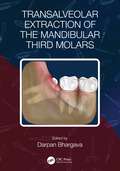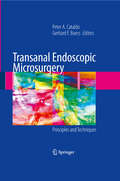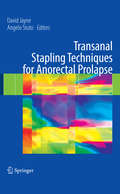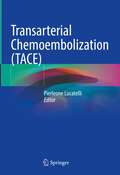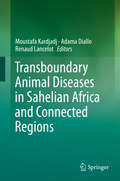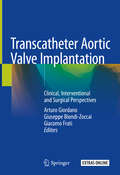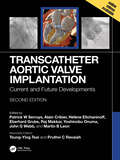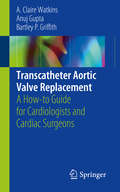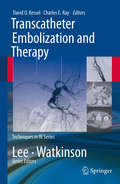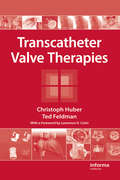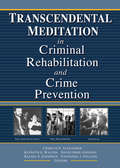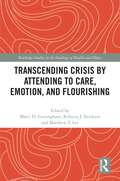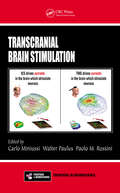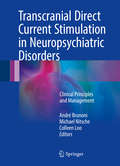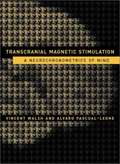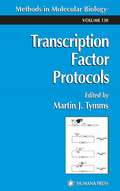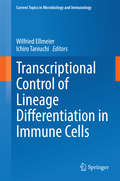- Table View
- List View
Transactions 28th European Strabismological Association Meeting: Transactions of the 28th ESA Meeting, Bergen Norway, June 2003
by Jan-Tjeerd H.N. de FaberThis book contains all oral presentations, posters, and workshop transactions of the 28th Meeting of the European Strabismological Association that took place in Bergen, Norway. The highlight of the meeting is the ESA-lecture what can eye muscle studies tell us about strabismus by Prof. Gunnar Lennerstrand from Stockholm. All 60 oral presentations of the following sessions are described: screening, amblyopia, eye movements, vision, refraction, nystagmus, stereopsis, exotropia, vergence problems, refractive surgery, cataract and strabismus, strabismus surgery, botulinum toxin, EMG, oblique muscles, paralytic strabismus, thyroid, duane syndrome and varia.
Transalveolar Extraction of the Mandibular Third Molars
by Dr Darpan BhargavaThis practical manual provides details on the clinical and radiographic evaluation, classification, principles of suturing and flaps, intricacies of the transalveolar surgery, newer advances in mandibular third molar surgery and complications that may be encountered during mandibular third molar exodontia. It presents vital surgical skills for the mandibular third molar exodontia in a concise and to-the-point manner. This book is a user-friendly resource for students of dentistry and maxillofacial surgery, as it brings together information from various reputable resources to one single platform for easier understanding and application. Key Features: Addresses the necessary gap in the literature with a concise yet comprehensive approach. Overhauls and updates the content to provide an exam-oriented text for students of oral and maxillofacial surgery, and professionals.
Transanal Endoscopic Microsurgery
by Peter Cataldo Gerhard F. BuessTransanal endoscopic microsurgical techniques have recently been proven a safe and effective way to remove tumors from the rectum. Patients with small (4 cm in diameter or less), early malignant tumors are candidates for TEM as are patients with benign tumors of any kind. Preoperative biopsies and staging are essential, and patient selection is key to achieving successful outcomes with these procedures. Transanal Endoscopic Microsurgery covers indications/contraindications, equipment, operative techniques, oncologic results, and an evidence-based comparison of TEM and traditional approaches. Written by the innovators of these techniques, this book is an essential reference for surgeons who want to incorporate TEM into their practice.
Transanal Stapling Techniques for Anorectal Prolapse
by Angelo Stuto David JayneThe time is right for a textbook addressing transanal stapling techniques for anorectal prolapse. Both stapled haemorrhoidopexy and STARR have recently enjoyed widespread exposure and their application is spreading rapidly both through Europe and the USA. However, many areas of controversy remain and warrant comprehensive discussion. Current thinking on anorectal prolapse has evolved significantly in recent years and this needs to be updated in the literature. In addition, it is essential that the correct principles of transanal stapling are documented to aid training in techniques and to avoid unwanted complications. There is no other surgical textbook on the market that deals with this expanding area of Coloproctology.
Transarterial Chemoembolization (TACE)
by Pierleone LucatelliThe book thoroughly presents Transarterial Chemoembolization (TACE), a procedure representing the standard of care for several clinical oncological indications.Thanks to the considerable technological advances in the available instrumentation (guidewire, microcatheter, guiding imaging modalities) as well as the different platforms utilized to perform treatment (conventional TACE, drug eluted TACE, degradable starch microsphere TACE) indication for treatment has been broadened and results significantly improved.By clearly depicting the procedure, with technical details, advantages and limitations, the book provides a unique and most updated source on TACE procedures. Clinical cases regarding crucial parts of the procedure are also provided.Expert users as well as novel clinicians interested in the most recent aspects of this interventional radiology procedure will find in this book a valuable tool and guide for their clinical routine.
Transboundary Animal Diseases in Sahelian Africa and Connected Regions
by Renaud Lancelot Moustafa Kardjadj Adama DialloThis book primarily focuses on the African Sahel region, shedding new light on the epidemiology, socio-economics, clinical manifestations and control approaches of transboundary animal diseases (TADs) in this specific region. In addition to the description of TADs in Sahelian Africa and connected regions, several issues regarding the burden of TADs, the role of national/regional/international veterinary organizations in the surveillance process, animal mobility, one health and TADs in the dromedary are discussed. The book contains 22 chapters and is structured in three parts, i- general features and commonalities, ii- viral diseases, iii- bacterial diseases. Each chapter was written by a group of experts specialized in the topic. This work will be of general interest to researchers, veterinarians, veterinary public health officers, and students engaged in the surveillance and control of animal infectious diseases, included those of zoonotic nature and that are prevalent in the Sahel.
Transbronchial cryobiopsy in diffuse parenchymal lung disease
by Venerino PolettiThis book presents both theoretical and practical aspects of transbronchial cryobiopsy, a new diagnostic technique for the detection of diffuse parenchymal lung disease that is attracting great interest in the scientific community. In the context of a multidisciplinary discussion, comprising radiologic-pathologic correlations, the authors examine the technical and safety issues – such as equipment, endoscopic setting, anesthesiologic approaches and bleeding control – on one hand, and the diagnostic yield and clinical meaning on the other.The volume offers several case studies – including idiopathic pulmonary fibrosis, granulomatous disorders, interstitial pneumonias, rare lung disseminated tumors– that illustrate the high diagnostic yield and safety of this innovative technique. The book appeals to a wide readership, including residents, pulmonologists with expertise in diffuse parenchymal lung diseases, interventional pulmonologists, thoracic radiologists, pathologists, anesthesiologists, internists and rheumatologists.
Transcatheter Aortic Valve Implantation: Clinical, Interventional and Surgical Perspectives
by Giuseppe Biondi-Zoccai Arturo Giordano Giacomo FratiThis book provides comprehensive information on transcatheter aortic valve implantation (TAVI), which was introduced for the treatment of aortic valve disease less than two decades ago. It explains how TAVI has delivered satisfactory results even in high and intermediate risk patients and outlines how it continues to evolve, thus requiring awareness of state of the art approaches to indication, risk stratification, device choice, procedure, and follow-up. In addition, it reports on the complex and multidisciplinary approach needed to maximize the efficacy, safety, and appropriateness of TAVI, providing detailed clinical, interventional and surgical perspectives focusing on the development of this cardiovascular intervention. Starting with the history of TAVI, addressing the interventional anatomy of aortic valve disease, and reporting on the expert authors’ day-to-day experiences, this highly informative book offers an essential update for all cardiologists and surgeons interested in transcatheter aortic valve implantation, as well as any clinician, decision-maker and stakeholder involved in patient selection, procedural management, and follow-up.
Transcatheter Aortic Valve Implantation: Current and Future Developments
by Yoshinobu Onuma Raj Makkar Patrick W Serruys Alain Cribier Hélène Eltchaninoff Eberhard Grube John G Webb Martin B LeonWritten by pioneers in the field of interventional cardiology, this new edition provides readers with the information and expert guidance needed to perform safe and effective transcatheter aortic valve implantation/replacement (TAVI/TAVR). The book is supplemented by visual aids, including more than 300 illustrations and videos.
Transcatheter Aortic Valve Replacement Program Development: A Guide for the Heart Team
by Marian C. Hawkey Elizabeth M. Perpetua Sandra Lauck Amy SimonePublisher's Note: Products purchased from 3rd Party sellers are not guaranteed by the Publisher for quality, authenticity, or access to any online entitlements included with the product. Launch and cultivate a successful program for the innovative procedure poised to become the standard for patients with aortic stenosis (AS) with Transcatheter Aortic Valve Replacement (TAVR) Program Development: A Guide for the Heart Team. Written by leaders in the field, this clinical instruction manual is the first to consolidate evidence, guidelines, and best practices for the TAVR care pathway from referral to follow-up. This is a must-have for clinicians—nurses, physicians, and allied health professionals—as well as administrative leadership and staff involved in TAVR programs. The text offers a comprehensive view of the TAVR program organized to support staff and quality, and positioned to grow on pace with evolving indications, regulations, technology, and patient needs.
Transcatheter Aortic Valve Replacement: A How-to Guide for Cardiologists and Cardiac Surgeons
by A. Claire Watkins Anuj Gupta Bartley P. GriffithThis concise manual describes in detail how to perform a transcatheter aortic valve replacement (TAVR) procedure and provides cardiac surgeons and cardiologists with the foundation necessary to begin practicing TAVR. It includes background on the landmark data establishing the field of TAVR, instructions in the pre- and post-operative management of TAVR patients, and technical descriptions of the newest and most common devices and how to use them. Written by leaders in the field, it offers an unbiased, academic review and describes the experience of colleagues who have learned through trial and error. The Transcatheter Aortic Valve Replacement Manual is an essential resource for physicians and related professionals, residents, fellows, and graduate students in cardiology, cardiac surgery, thoracic surgery, and vascular surgery
Transcatheter Embolization and Therapy
by David Kessel Charles RayLee and Watkinson's Techniques in Interventional Radiology series of handbooks describes in detail the various interventional radiology procedures and therapies that are in current practice. The series covers procedures in angioplasty and stenting, transcatheter embolization and therapy, biopsy and drainage, and ablation. Forthcoming are volumes on pediatric interventional radiology and neurointerventional radiology. Each book is laid out in bullet point format, so that the desired information can be located quickly and easily. Interventional radiologists at all stages, from trainees through to specialists, will find this book a valuable asset for their practice. Transcatheter Embolisation and Therapy approaches the procedure in two ways . Section I systematically describes the techniques of transcatheter embolization and addresses the issues surrounding embolization procedures. Section II presents specific organ systems and pathologies that undergo embolization therapy. Dr. David Kessel is a Consultant Radiologist at the Leeds Teaching Hospitals, UK, and Dr. Charles Ray, Jr. is Professor of Radiology and Co-Director of Research at the University of Colorado Denver Health Sciences Center, USA.
Transcatheter Mitral Valve Therapies
by Ron Waksman Toby RogersTRANSCATHETER MITRAL VALVE THERAPIES An essential survey of the advancing field of transcatheter mitral valve repair and replacementMinimally invasive transcatheter therapies have revolutionized the treatment of structural heart disease. Greatly improving outcomes for higher-risk patients, transcatheter aortic valve replacement is now established as a safe and effective alternative to invasive surgery. The mitral valve, however, poses further challenges. Contending with one of the heat’s most anatomically and pathologically complex components, practitioners and engineers have yet to perfect a stream-lined, widely deliverable therapy—though they are getting closer and closer to this goal.Transcatheter Mitral Valve Therapies provides a far-reaching survey of the field of mitral interventions in its current state. Highlighting the stumbling blocks preventing transcatheter mitral valve replacement’s widespread adoption, the book’s international group of contributors discuss the improvements to be made in repair and replacement procedures, as well as the adjunctive use of imaging and pharmacologic therapies. This ground-breaking text:Provides detailed explanations of transcatheter repair, transcatheter replacement, and adjunctive proceduresFeatures chapters on the use of imaging to aid in patient selection, procedure planning, and intra-operative guidanceDiscusses the importance of minimally invasive approaches for mitral valve repairExamines anticoagulation following transcatheter mitral valve interventionsOutlines the possible future of transcatheter mitral valve therapyTranscatheter Mitral Valve Therapies is an important, up-to-date resource for interventional cardiologists, as well as all clinical researchers and practitioners seeking information on this vital and developing treatment.
Transcatheter Valve Therapies
by Ted Feldman Christoph HuberThe landscape of cardiac surgery is changing, as is the field of interventional cardiology. The idea of accessing and replacing a failing valve through the patients vasculature has become the most rapidly expanding therapy of choice in cardiovascular disease. Transcatheter Valve Therapies chronicles the astonishing advances that have taken place in
Transcend Fear: A Blueprint for Mindful Leadership in Public Health
by Joseph LadapoA fascinating look into the life of a state surgeon general and how his public health decisions provide a blueprint for fearless leadership and better national health policy. Florida Surgeon General Joseph Ladapo shares the inspiring story of how he came to be who he is. After experiencing abuse as a child, Dr. Ladapo was incapable of connecting emotionally with other people. He was dissociated from virtually everything in his life and numbly powered through college, medical school, and residency to become a doctor and university professor. It wasn&’t until he fell in love with his wife that he was forced to come face-to-face with the enormous emotional and spiritual disruption caused by his deeply buried trauma. Just before the pandemic, Dr. Ladapo worked with a former Navy Seal who used a mix of ancient disciplines and modern techniques to help free him from this trauma—and subsequently, his fear. When the pandemic hit Los Angeles, Dr. Ladapo found himself well-equipped to observe the panic and fear that overtook the hospital where he was working—and the country—without becoming part of it. From this state of emotional clarity, he recognized that it was too late to take any public health measures that would significantly change the deadliness of the pandemic, and that it was more important to face the challenge squarely and focus on building capacity to treat patients without destroying society in the process. His message that panic, fear, and politics were fueling harmful decisions—like disavowing the possibility that hydroxychloroquine could effectively treat COVID-19—made him the target of fierce criticism. In Transcend Fear: A Blueprint for Mindful Leadership in Public Health, Dr. Ladapo describes his views on public health restrictions, early home treatment, and COVID-19 vaccines, along with how Florida officials made public health decisions that set it apart from other states—and nations. Based on this experience, Dr. Ladapo explains how states can make better public health decisions in the future, recommending that health officials obtain training in decision analysis and expand their consciousness of how fear can shape perspectives and create dangerous outcomes—particularly during a crisis.
Transcendental Meditation® in Criminal Rehabilitation and Crime Prevention
by Kenneth G Walton David Orme-Johnson Rachel S GoodmanIn contrast to the generally dismal results of various approaches to rehabilitation, these consciousness-based strategies have proven effective in preventing crime and rehabilitating offenders! This book will introduce you to a powerful, unique approach to offender rehabilitation and crime prevention. In contrast to the generally dismal results of most rehabilitation approaches, studies covering periods of 1-15 years indicate that this new approach-employing the Maharishi Transcendental Meditation® and TM-Sidhi programs-reduces recidivism from 35-50%. Transcendental Meditation® in Criminal Rehabilitation and Crime Prevention provides the reader with a theoretical overview, new original research findings, and examples of practical implementation. With this book, you will explore what motivates people to commit crimes, with emphasis on stress and restricted self-development. Then you'll examine the results and policy implications of applying these consciousness-based techniques to offender rehabilitation and crime reduction. Most chapters include tables or figures that make the information easy to understand. Transcendental Meditation® in Criminal Rehabilitation and Crime Prevention does not merely review the theory behind this innovative approach to rehabilitation and prevention but also emphasizes the practical value of the programs it describes and reports how techniques and strategies based on Transcendental Meditation® have been put to use in a variety of settings. This book will familiarize the reader with: a rehabilitation approach so universal in its applicability that any adult or juvenile offender can begin it at the point of sentencing, during incarceration, or at the point of parole the in-depth background on adult growth and higher states of consciousness necessary to understand this consciousness-based, developmental approach the results of empirical studies conducted in prisons around the country, with up to 15 years of follow-up a preview of how cost-effective the rehabilitation program might be implications for public policy and the judicial system-including an innovative alternative sentencing program how this approach deals not only with individuals but also with the community as a whole-when practiced by a small percentage of the population, the TM and TM-Sidhi programs may reduce crime in the larger community how these society-level prevention programs may prove to be effecitive in reducing not only school violence in the community but, if applied on sufficient scale, war deaths and terrorism in the greater society
Transcending Crisis by Attending to Care, Emotion, and Flourishing
by Marci D. CottinghamThis book offers new empirical research and policy-relevant care practices from across the globe to understand the interrelation of care, emotion, and flourishing in the context of acute and persistent crises. From COVID-19 responses around the world to the opioid epidemic in the United States, this volume investigates collective and individual crises as symptoms of underlying systemic pathologies. Crises require deep engagement with both structure and culture, drawing on interdisciplinary perspectives from sociology, nursing, social work, and psychology. Addressing the multi-level challenges of caregiving in families, schools, organizations, and communities, this book presents examples of research and practice that demonstrate compassion, resilience, productive collaboration, and flourishing. It documents the social conditions and processes that spawn effective solutions and positive emotional and health outcomes, which often occur amid chaos, rapid social change, and substantial suffering. The first section focuses on care, emotions, and flourishing in healthcare and educational contexts to examine nurses, students, and teachers as they respond to enduring and acute crises. Section two turns to community and family contexts to understand how emotions and care intertwine in the flourishing practices of women and communities facing isolation during COVID-19, parents of opioid users, and international efforts to address child abuse and healthy aging. Geographically, the book covers experiences in Canada, Ghana, India, Italy, Sweden, the United Kingdom, and the United States. Each chapter discusses how we can move from managing emotions and coping with crisis to transcending crisis and promoting flourishing. The book includes case studies that illustrate hopeful and successful practices that might help us meet the challenges we face in this moment and move through them with compassion and enhanced flourishing. Examining care across a range of professional contexts, including healthcare, education, community, and family settings, the authors explore similarities and differences in how these contexts shape care practices in light of collective threats and crises. This book is also a valuable contribution to the literatures on health and illness, the sociology of emotions, and the interdisciplinary field of well-being and flourishing.
Transcranial Brain Stimulation
by Walter Paulus Carlo Miniussi Paolo M. RossiniSince the discovery of transcranial magnetic stimulation (TMS) and transcranial electrical stimulation (tES), these non-invasive brain stimulation (NIBS) techniques have been used to investigate the state of cortical excitability, and the excitability of the cortico-cortical and corticospinal pathways. In addition, these techniques have been found
Transcranial Direct Current Stimulation in Neuropsychiatric Disorders
by André Brunoni Michael Nitsche Colleen LooThe aim of this book is to provide a comprehensive review of the use of Transcranial Direct Current Stimulation (tDCS) in different psychiatric conditions. Here we review tDCS clinical studies employing different types of design (from single-session tDCS studies to randomized clinical trials) as well as studies evaluating the impact of tDCS in neurophysiological, behavioral and brain imaging outcomes. Although the understanding about physiological foundations and effectiveness of clinical therapies of psychiatric diseases has been considerably increased during the last decades, our knowledge is still limited, and consequently psychiatric diseases are still a major burden to the individual patient and society. Recently, interest in pathological alterations of neuroplasticity in psychiatric diseases as a critical condition for development, and amelioration of clinical symptoms increased, caused by the fact that new tools, such as functional imaging, and brain stimulation techniques do allow to monitor, and modulate these phenomena in humans. Especially non-invasive brain stimulation techniques evolved as an attractive potential new therapeutic tool. The interest in non-invasive brain stimulation has grown exponentially in the past 25 years, with the development of non-pharmacological, neuromodulatory techniques such as tDCS and repetitive transcranial magnetic stimulation (rTMS). TDCS, although even newer than rTMS, has attracted considerable attention in both basic and clinical research scenarios. In the context of clinical research, tDCS is being increasingly investigated as a novel treatment tool for several psychiatric disorders, such as major depression, schizophrenia and neurocognitive and substance abuse disorders. Transcranial Direct Current Stimulation in Neuropsychiatric Disorders - Clinical Principles and Management intends to serve as a practical guide on the field, attracting the interest of psychiatrists, neurologists and neuroscientists with little or no experience with tDCS, as well as those with a background on tDCS who want to increase their knowledge in any particular psychiatric condition.
Transcranial Direct Current Stimulation in Neuropsychiatric Disorders: Clinical Principles and Management
by Michael A. Nitsche André R. Brunoni Colleen K. LooThe 2nd edition of this book incorporates the tremendous clinical advances that have occurred in the field of transcranial direct current stimulation (tDCS) over the past 5 years. Since the 1st edition was published, the clinical use of tDCS has moved from its infancy, and is now in a thrilling new phase with numerous possibilities as well as challenges. tDCS is a technique that excels in terms of safety and tolerability, and within a few years, novel technological developments will allow its use at home. At the same time, large, phase III trials have been exploring the clinical efficacy of tDCS, the results of which have been published in leading journals such as the New England Journal of Medicine and JAMA Psychiatry. This 2nd edition summarizes the state of the art of the field. Written by leading experts in the field, the book is divided into 5 parts: Introduction and Mechanisms of Action; Research Methods; tDCS in the life cycle; Applications of tDCS in neuropsychiatric disorders (further divided into Psychiatry and Neurology); and The clinical use of tDCS. It also includes several new chapters, covering topics such as precision stimulation of tDCS; combination of tDCS with different neuroimaging modalities; and use of tDCS in new clinical conditions. Moreover, all chapters have been rewritten and updated. This book will be of significant interest to psychiatrists, neurologists and neuroscientists new to the field as well as those with a background in tDCS who want to increase their understanding of particular psychiatric conditions.
Transcranial Magnetic Stimulation: A Neurochronometrics of Mind
by Stephen M. Kosslyn Vincent Walsh Álvaro Pascual-LeoneThe mainstays of brain imaging techniques have been positron emission tomography (PET), functional magnetic resonance imaging (fMRI), magnetoencephalography (MEG), and event-related potentials (ERPs). These methods all record direct or indirect measures of brain activity and correlate the activity patterns with behavior. But to go beyond the correlations established by these techniques and prove the necessity of an area for a given function, cognitive neuroscientists need to be able to reverse engineer the brain--i.e., to selectively remove components from information processing and assess their impact on the output. This book is about transcranial magnetic stimulation (TMS), a technique that emerged during the same period as neuroimaging and has made it possible to reverse engineer the human brain's role in behavioral and cognitive functions. The subject areas that can be studied using TMS run the gamut of cognitive psychology--attention, perception, awareness, eye movements, action selection, memory, plasticity, language, numeracy, and priming. The book presents an overview of historical attempts at magnetic brain stimulation, ethical considerations of the technique's use, basic technical and practical information, the results of numerous TMS studies, and a discussion of the future of TMS in the armamentarium of cognitive neuropsychology.
Transcription Factor Protocols
by Martin J. TymmsMartin Tymms has created a powerful collection of key techniques for the study of those DNA sequences and protein factors that regulate the transcription of protein encoding genes. This practical compendium includes not only well established protocols, but also novel techniques that are now being widely adopted. Among the important new methods treated are the use of triplex-forming oligonucleotides, the application of whole genome PCR to the isolation of gene promoters/enhancers, the analysis of in vivo methylation, and in vivo footprinting using UV light and ligation-mediated PCR. Transcription Factor Protocols provides both experienced workers and new researchers with a vital first-stop reference for all those exploring the role of transcription factors in gene regulation today.
Transcription factors in blood cell development (Advances in Experimental Medicine and Biology #1459)
by Tilman Borggrefe Benedetto Daniele GiaimoThis book describes transcription factors in the context of hematopoietic development and reveal mechanistic insights how they orchestrate specific gene expression patterns. Several examples from lymphoid and myeloid lineages are given as well as particular examples of leukemia fusion proteins that contain a part of a transcription factor. In the given chapters covering each one particular example, the function of transcription factors is characterized in normal as well as leukemic contexts. New technologies such as ChIP-Seq or RNA-Seq, that make use of genome-wide sequencing, have shown that such master regulators of blood cell development often work in combinatorial fashion and, when dysregulated, results in leukemogenesis. This book is not only intended for experts but it should also be a useful resource for younger scientists or scientists from other disciplines, who may use this book as a stimulating starting point for further discoveries and/ or translational endeavors.
Transcriptional Control of Lineage Differentiation in Immune Cells
by Wilfried Ellmeier Ichiro TaniuchiInsights into the regulation of immune cell lineage differentiation and specification as well as into the control of lineage integrity, stability and plasticity are of fundamental importance to understanding innate and adaptive immune responses. In this volume, leading experts provide an up-to-date and comprehensive overview of recent advances in the transcriptional control mechanisms and transcription factor networks that regulate these processes in a variety of different immune cell lineages. The chapters cover the regulation of T versus B cell lineage choice, discuss early B cell development and pre-B cell leukemia prevention, address transcriptional control mechanisms during the differentiation, in regulatory T cells and iNKT cells, detail genomic switches in helper cell fate choice and plasticity and highlight the role of the BTB-zinc finger family of transcription factors in T cells. Moreover, the chapters discuss transcriptional networks in DCs, NK cells and in innate lymphoid cells. Together, the reviews illustrate key transcriptional control mechanisms that regulate the development and function of immune cells and demonstrate the impressive advances made over the last decade.
Transcriptional Regulation
by Ales VancuraThrough many recent remarkable developments, perhaps the most significant advancements in the study of transcriptional regulation are the development of genome-wide approaches for measuring gene expression, exemplified by gene chips (chip), and chromatin immunoprecipitation assays (ChIP) for measuring in vivo protein-DNA interactions at any genomic loci. Transcriptional Regulation: Methods and Protocols takes this progress and builds upon it with a collection of key protocols used in expert laboratories around the world. Divided into four convenient sections, this detailed volume explores promoter elements, transcription factors, and preinitiation complex (PIC) assembly, chromatin structure, chromatin modifying complexes, and RNA synthesis and regulation. Written in the highly successful Methods in Molecular BiologyTM series format, chapters include introductions to their respective topics, lists of the necessary materials and reagents, step-by-step, readily reproducible laboratory protocols, and vital tips on troubleshooting and avoiding known pitfalls. Comprehensive and accessible, Transcriptional Regulation: Methods and Protocols equally serves senior researchers and scientists experienced in transcriptional regulation as well as graduate students and scientists who wish to study transcriptional regulation for the first time.

